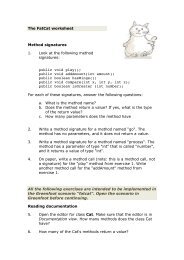SCIENCE TEST
SCIENCE TEST
SCIENCE TEST
Create successful ePaper yourself
Turn your PDF publications into a flip-book with our unique Google optimized e-Paper software.
depth (m)<br />
10<br />
20<br />
30<br />
40<br />
osit is thinnest<br />
3, the smallest<br />
lake clay was<br />
f the lake clay<br />
to Site 3, the<br />
30<br />
glacial<br />
till<br />
F. increases. 40<br />
G. remains the same.<br />
H. first increases and then decreases.<br />
J. decreases.<br />
Figure 3In<br />
Figure 2, the key shows us that the glacial till is indicated with stripes. As we<br />
move left from Grand Forks to Site 3, we see that the area of the glacial till gets<br />
thinner. So the thickness of the glacial till decreases.<br />
9. According to Figure 2, which of the following graphs<br />
best represents the elevations, in m above sea level, of<br />
the top of the glacial till layer at Sites 1, 2, and 3 ?<br />
A.<br />
B.<br />
lake<br />
clay<br />
18 16<br />
___________________________<br />
O/ O of groundwater Answer: sample J.<br />
18 16<br />
O/ O of standard water sample<br />
y, and T. W. D. Edwards, “Isotopic Composition of Old Ground Water from Lake Agassiz:<br />
by the American Association for the Advancement of Science.<br />
elevation<br />
(m above sea level)<br />
elevation<br />
(m above sea level)<br />
225<br />
200<br />
175<br />
150<br />
225<br />
200<br />
175<br />
150<br />
1<br />
1<br />
depth (m)<br />
O = – 1 × 1,000<br />
2<br />
Site<br />
2<br />
Site<br />
3<br />
3<br />
10<br />
20<br />
C.<br />
D.<br />
elevation<br />
(m above sea level)<br />
elevation<br />
(m above sea level)<br />
225<br />
200<br />
175<br />
150<br />
225<br />
200<br />
175<br />
150<br />
1<br />
1<br />
lake<br />
clay<br />
2<br />
Site<br />
2<br />
Site<br />
10. Precipitation that falls at Sites 1, 2, and 3 soaks into<br />
Answer: the soil C. until it reaches the groundwater table about<br />
3 m below the surface. Based on Figure 3, and assuming<br />
no alteration of the precipitation, the δ<br />
Notice that the word elevation appears in italics in this question. In previous<br />
questions about Figure 2, we’ve been look at the thickness of different layers.<br />
Whoever wrote the question wants to make sure that we pay attention to elevation<br />
instead of thickness.<br />
18 O value of<br />
present-day precipitation in the study area is closest to:<br />
F. −26.<br />
G. −23.<br />
H. −20.<br />
J. −15.<br />
In Figure 2, the elevation of a layer is shown with numbers along the vertical axis<br />
labeled “elevation GO (m ON above TO sea THE level)”. NEXT So, PAGE. for example, the top of the glacial till is<br />
45 230 m at Winnipeg and 200 m at Site 1. Looking at sites 1, 2, and 3, we see that the<br />
elevation of the top of the glacial till is highest at Site 2 and lowest at Site 3, so C is<br />
the only possible answer.<br />
10. Precipitation that falls at Sites 1, 2, and 3 soaks into the soil until it reaches the groundwater table about<br />
3 m below the surface. Based on Figure 3, and assuming no alteration of the precipitation, the δ18Ο value<br />
of present-day precipitation in the study area is closest to:<br />
F. −26.<br />
3<br />
3



